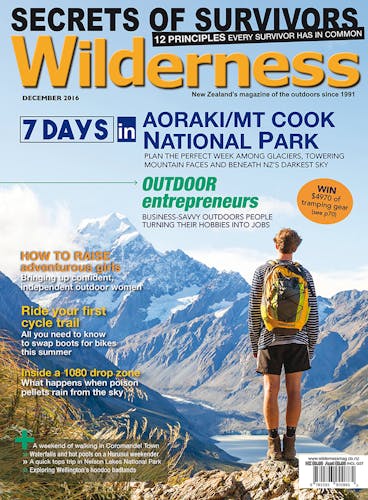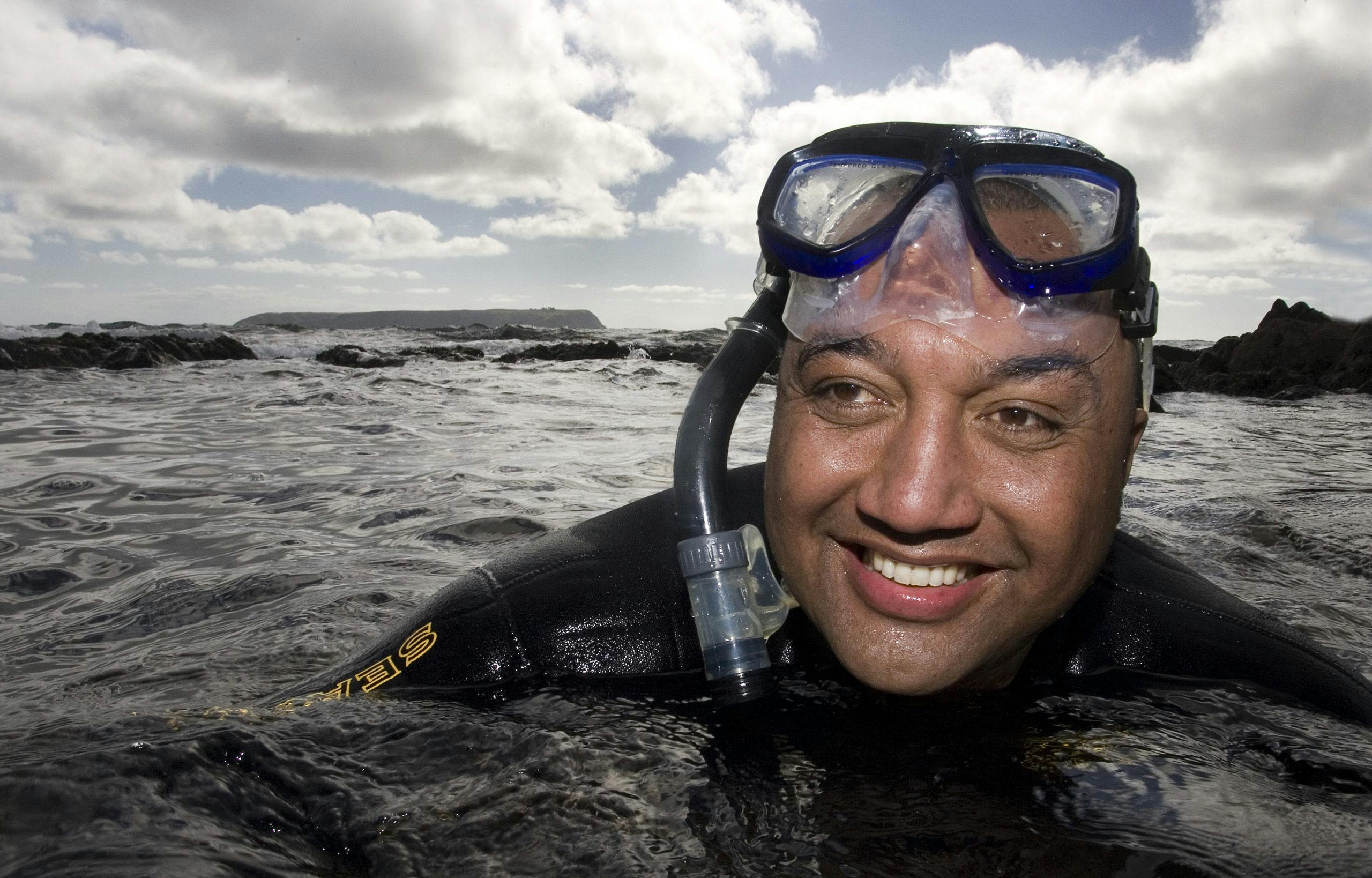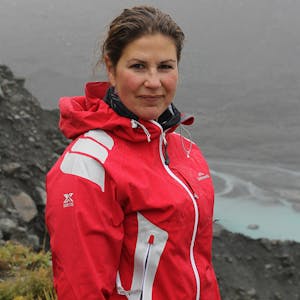There are some things every wilderness survivor has in common, discovers Carrie Miller
Jamie Hareb planned his nine-day solo hike meticulously. A “born and bred skier” with a passion for mountains, he had spent the past year venturing further into the backcountry.
“My treks gradually started getting bigger,” Hareb said. “I went to Franz Josef and worked as a glacier guide for about four months. I also went on an avalanche awareness course in Wanaka.”
When Hareb had time off at the end of September, he approached his boss. “I told him what I wanted to achieve and we sat down together and looked at maps, looked up avalanche advisory warnings for the area,” Hareb said. “Nine days was plenty of time, and I gave myself two to three extra days. I left my intentions with my boss, agreed I would activate my [locator] beacon each night so my boss knew I was on track, and I had all of the essentials, including first aid, crampons, ice axes, food for days.”
Hareb’s plan was to park at the bottom of the Copland River, walking to Mt Cook Village via the the Karangarua Valley, Mt Howitt, Douglas Pass and Mt Montgomerie. From the village, he would hike over Copland Pass, eventually walking back to his car.
Day five started like the previous four days. After breakfast and a map check, Hareb left his overnight rock bivvy about 8am and got to the base of the mountain around 11am. “The plan was to pass left of Montgomerie over Fyfe Pass and stay at Barron Saddle Hut,” Hareb said. “I was around 1200m going up and over a pass about 2100m. I had chosen the pathway on the left next to the cliff because it was still shaded.”
What Hareb didn’t realise was that, even though his path was shaded, up above him Mt Montgomerie had been exposed to sunlight and the snow had weakened. Suddenly he heard a loud crack, and saw a wave of snow and ice bearing down on him.
Like a man trying to escape rising flood waters, Hareb scrambled up the side of the path as high as he could go to avoid the avalanche. “At first I was thinking: ‘Oh, sweet, I dodged a bullet here’, but then it got higher and higher and that thought changed to: ‘Oh no, this is going to be very detrimental to me’,” Hareb said. “I remember the first ice boulder popping over the ridge where I was standing. I hurdled that one, but then I got swept off my feet and it was all on.”
Hareb was carried about 100m over a span of five or 10 seconds. His upper body was slammed into a rock, cutting his face, while his legs were crushed and twisted in the avalanche flow.
“I was just at the mercy of nature,” Hareb said. “My head was going down in the direction of the avalanche, and I was looking up at Mt Montgomerie, pushing my hands down on ice boulders to keep myself afloat. I knew to stay alive I had to stay on top of this. I didn’t really have time to think, it was just a roller coaster.”
Eventually Hareb managed to grab hold of a boulder and pulled himself out of the flow.
“I sat on the side as this wave of ice moved past me with this growling noise, it was just unreal. And then I did a damage check.”
Hareb had multiple lacerations, and he had broken the femur and ankle of his left leg, as well as damaging the ACL in his left knee.
“Luckily I still had my pack on,” he said. “I think my head, neck and back were sweet because the pack acted as a barrier. I realised I was just about as remote as I could get, but thankfully it was a warm day.”
In 2006, after 20 years in the navy, Rob Hewitt was on long service leave. Despite being a navy diver, his experience didn’t translate to standard dive qualifications, and so he found himself an open water dive course with eight men he didn’t know near Mana Island.
“I had all my navy dive gear on, to the point where I even had my tether on my arm to tether off to my dive buddy, and my instructor said: ‘Oh, we don’t do that here’,” Hewitt said. “Straight away I thought, okay, I need to find a way to fit in.”
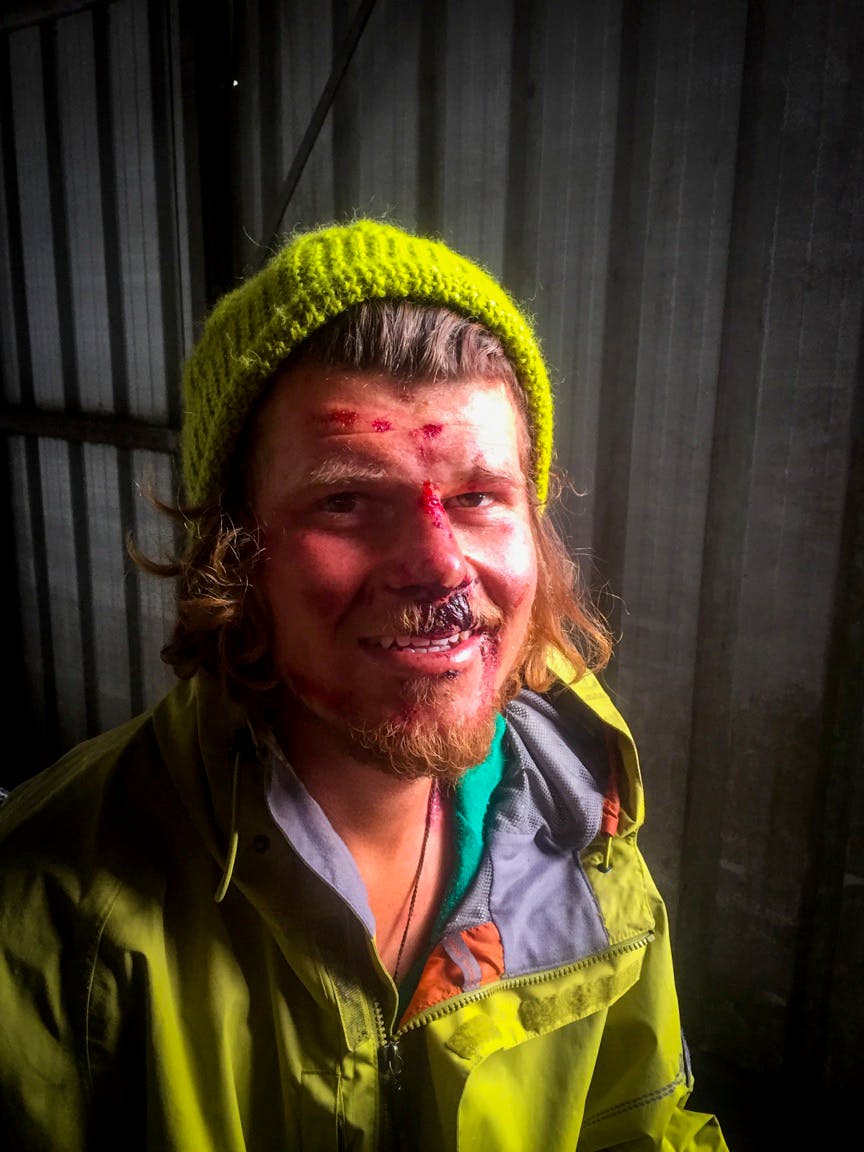
Jamie Hareb suffered a broken femur and ankle, as well as bruising and lacerations. Photo: Supplied
On the second dive, Hewitt’s buddy couldn’t equalise, and the instructor suggested Hewitt go off on his own. “Being a navy diver, I had certain training and experience I thought would keep me safe,” Hewitt said. “Safety is paramount in the navy, and I put safety aside to fit in with the group. I didn’t want to be the navy diver who said: ‘No, I’m not diving without a buddy’, when, of course, that’s exactly what I should have done.”
The instructor was allowing students to dive for crayfish, so Hewitt went down to 12m and “two minutes later, I saw a crayfish and put it in my bag,” he said. “Then I leaned over a canyon and saw 20 or 30 crayfish. I remember seeing all the crayfish turning to look at me, and the next minute I was caught in a rip and dragged 800m within a minute. I surfaced off the stern of the boat. The other divers were surfacing in front of the boat, and the boat was advancing to pick them up. No one on the boat looked behind.”
So began Hewitt’s four-day ordeal adrift at sea.
Rob Hewitt’s survival story is well known throughout New Zealand, and it began very differently to Jamie Hareb’s. Whether you’re alone or in a group, in the backcountry or at sea, even if you’re under the care of an instructor, things can go horribly wrong.
Author Laurence Gonzales has been studying survival stories like Hewitt’s and Hareb’s for more than four decades, writing several books on the subject, including the best-selling Deep Survival. Gonzales has spent the better part of his life looking into who lives, who dies, and why – what is happening physiologically and psychologically, how experience and modern equipment can betray us, searching for that very fine line between living to tell the tale, and death.
In Deep Survival, he writes: “In reading about cases in which people survived seemingly impossible circumstances, I found an eerie uniformity. Decades and sometimes even centuries apart, separated by culture, geography, race, language, and tradition, they all went through the same patterns of thought and behaviour. I eventually distilled those observations down to 12 points that seemed to stand out concerning how survivors think and behave in the clutch of mortal danger.”
Here’s what Gonzales says survivors have in common.
1. Perceive, believe
As Jamie Hareb sat on the ice, covered in his own blood, he quickly realised his priority was to stay alive. “I thought it was probably a very good time to press the SOS button on my emergency locator beacon,” Hareb said. “I didn’t know if it worked, so I moved to the next order of business: staying warm, having some food. After two hours, I knew I had to start getting myself out, because there was some serious weather coming in and I was still on an avalanche-prone slope. So I started gingerly walking downhill.”
Rob Hewitt instinctively knew he was going to be playing a waiting game. “My first train of thought was to roll onto my back and swim to the boat, but by taking markers off the land I realised I wasn’t making headway. So I didn’t panic.”
Hewitt started calculating. Because he was the last diver in and since he had good lung capacity, the other divers wouldn’t be concerned about him for at least 45 minutes. After about 90 minutes, Hewitt saw the Westpac Rescue Helicopter circling the boat. “Okay, I thought, I’m on the right track,” he said. “I knew they had called mayday diver missing. After another 45 minutes, the helicopter left, and I created the scenario in my mind: it probably ran out of fuel, it was heading back to Wellington airport, and it would be out here in another 45 minutes or so. And I was right. After the second 45-minute search, it left again. Again, I didn’t panic. But then it didn’t come back, and that started to eat me.” (Hewitt later discovered the pilot had been diverted to a car accident and was unable to resume the search.)
“I’m 36-years-old and my life is coming down to 45-minute blocks. I started blaming everybody else, everybody but myself. I thought I was hitting rock bottom then, but I hadn’t even scratched the surface.”
When the sun set, he tried to remember who he knew that had survived a night floating out at sea. “I realised I didn’t know anyone. Therefore, I was going to confront my deepest fear, which was death.”
2. Stay calm
“I was in a good place,” Hareb said. “I was in so much pain I wasn’t in pain, if that makes sense. It didn’t matter what was sore. I was alive.”
Hewitt turned to prayer. “ I prayed in English and Māori. After I finished, I felt a warm sensation, relief. I’d never felt it before. And I thought to myself, that must be the core of what we’re about as human beings. That core actually gave me strength, identity and hope.”
3. Think, analyse, plan
Hareb had quickly formed a plan: damage check, activate his emergency locator beacon, get warm, eat, and then get down the hill and out of harm’s way. “If the helicopter didn’t come, I knew my best chance to survive was getting out of the avalanche path and putting up my tent to spend the night,” he said. “So, that’s what I set about doing. That was my focus.”
As the second day of his ordeal dawned, Hewitt was also making plans. “I hadn’t had any sleep and I told myself I have to stay alert in case a fisherman was heading out to his spot. I had four sea urchins and a crayfish in my bag, and I told myself I’d have one sea urchin every hour or so. “Twenty minutes later I finished my last urchin,” Hewitt laughed. “Discipline wasn’t a big thing for me. After the first one I could just feel that energy, my body was on a high, and that sort of took over.”
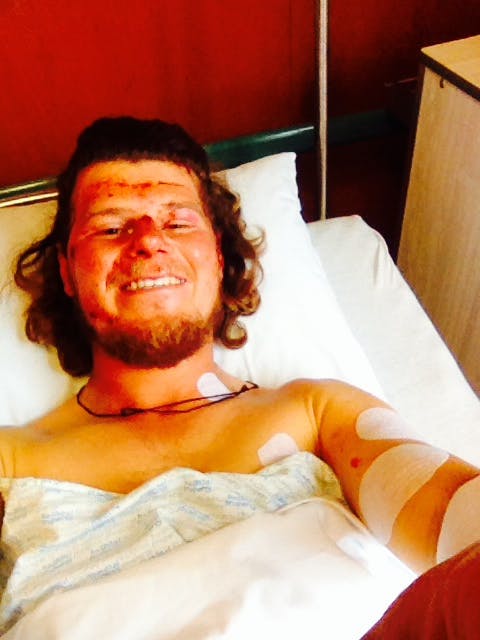
Hareb recovering from his injuries in hospital. Photo: Supplied
Hewitt got into a routine of checking his gear. “That’s where my training kicked in: navy divers are always checking their gear. I would routinely take the dive cylinder off, take my BCD off, bring it around, cradle it like a baby and purge my regulator onto my tongue to get a little moisture. I’d let a little water into my wetsuit to wake me up.”
4. Take correct, decisive action
“Moving was a big risk, especially having weak legs on an unstable slope. I knew that,” Hareb said. “But I also knew I was in an avalanche-prone area and had to get myself somewhere safe. Standing up was tough and moving hurt. I fell back down and spent a lot of energy getting back up, always telling myself to come on, get up. I basically was hobbling and sliding from ridge to ridge.”
After another long night at sea with no sleep, Hewitt was still taking any step he could to save himself. He used his mask to try and signal aeroplanes, and he tried swimming when the current was favourable, although the lack of food and water (he was no longer receiving moisture from his tank) led to dangerous blackouts.
5. Celebrate your successes
“When I first got off the avalanche, I was celebrating big time,” Hareb laughed. “I couldn’t believe I was alive.”
Hewitt said he didn’t have much to celebrate, other than the fact that he was still alive, which was getting more and more difficult to appreciate. “I continued to routinely check my gear and I was proud of that,” he said. “I guess that made me feel as though my navy training was still in play, as though I was doing something to help myself.”
6. Count your blessings
Neither Hareb nor Hewitt felt that family or loved ones were driving them to survive. “I knew I had a mission on my own hands and that I had to deal with that,” Hareb said. “That’s what was driving me. If I get out alive, then all the repercussions for my family are nullified, so that was my focus.”
7. Play
Hareb remembers being obsessed with his emergency locator beacon. “You never actually press the SOS button in practise, so I didn’t know what to expect,” he said. “I pressed it and hoped for the best. It surprised me when it started flashing. I became obsessed with the flashing. I’d check it every five seconds or so to make sure it was still flashing.”
Hareb also counted his way from one ridge line to the next during his painful descent. “I’d look at points where I could get to, and even if I fall over I’d tell myself I have to get to that objective. Then maybe I’ll take a break and reassess. I was so focused on what I was doing, that I completely forgot I called for a rescue helicopter, and it surprised the hell out of me when it showed up.”
Hewitt started playing a game on his first night at sea that he continued for the next two nights. “I called it the Walton Game. I was floating down near Pukerua Bay, it was dark, and I felt so alone. I knew the sun would rise in five or six hours, and I could see the lights of the houses in the ranges. So I’d choose a light, and I’d create a scenario. In that house is John Boy and Mary Lou. Their father is a baker. Their mother is a teacher. I’d create this figment of a family. When that light went out, I’d call out: ‘Good night John Boy! Good night Mary Lou!’ And then I’d move onto the next light. The last light went out about 3.30am.”
Hewitt also created a talisman in the crayfish he had caught, which was still alive in his dive bag. “I named him Tama, and I talked to him,” Hewitt said. “I told him if I lived, I would set him free. And if I wasn’t going to live, I’d set him free before I died.”
8. See the beauty
“It was the most gorgeous Friday I’d ever seen,” Hareb remembered. “After the avalanche had gone past and I was sitting in the sun, I was looking at the most glorious mountains and I was marvelling at this little frozen lake. I remember feeling lucky to be in this environment, to be seeing this.”
Even Hewitt managed to grasp moments of beauty. “At the end of that first night, the sun rose over the ranges, and all of a sudden I could see the movement of light coming over the trees and hitting the water, making it ripple like energy had just come through, and that energy came through me,” he said. “And I thought to myself: ‘Not too many people would be seeing that.’ So I thought myself fortunate, and I thought to myself: ‘Today’s the day you’re going to get rescued.’”
9. Believe that you will succeed
“It was a powerful mentality,” Hareb said. “I definitely had a strong attitude that this is my mission, this is what I need to do. The only other place I’ve felt that is climbing a mountain, when you’re trying to get to the top and you just have to block everything else out. Small steps are the ultimate goal.”
Hewitt said his belief that he’d survive started to wane after the second night. “I started hallucinating. I spent a lot of energy swimming to a power pole that was never there. When I realised it wasn’t there, I was so confused. I knew I had to be more careful from now on, but how do you do that when you can’t trust what your mind is telling you?”
10. Surrender
“Yeah, it hurt, but there’s a greater reward out there than a small bit of pain: getting out alive,” Hareb said. “You have to accept the new scenario and get on with it.”
By the third night at sea, Hewitt was experiencing more hallucinations. “Different things, like going into the petrol station to get a pie and a Coke, something I remembered that was a good thing. I think I was going through moments in my life I could connect with,” he said. “When I was myself, I’d pray. I asked my grandparents to intervene, but at the same time, if it’s my time to go, it’s my time to go. Once I had that realisation, I fell asleep in the water for about four hours and not a wave came over my face. When I woke up, the first thing I said was thank you to my grandparents: whatever you said to whoever you said it to, I’ll hold on.”
11. Do whatever is necessary
Hareb demonstrated this by hauling himself down a mountain on his broken leg and ankle. It would have been easier to wait in the sun for the helicopter, but Hareb was already focused on saving himself – so much so that he even forgot about the rescue helicopter. “It’s a pretty basic journey that you need to go on,” he said. “Get down and survive: that’s pretty much the only plan I had.”
At the end of the third day, Hewitt still had Tama, his crayfish. “I knew if I was going to survive this night, I’d have to eat Tama. But I went back and forth about it for a long time.”
Hewitt said a karakia and a tearful thank you, and cracked Tama open. “I made sure I was in a foetal position so I could grab every bit of nutrition that Tama was giving me, so he wouldn’t die in vain. I sucked everything I could out of him. All of a sudden, I felt energised. I’m sure that Tama saved my life.”
12. Never give up
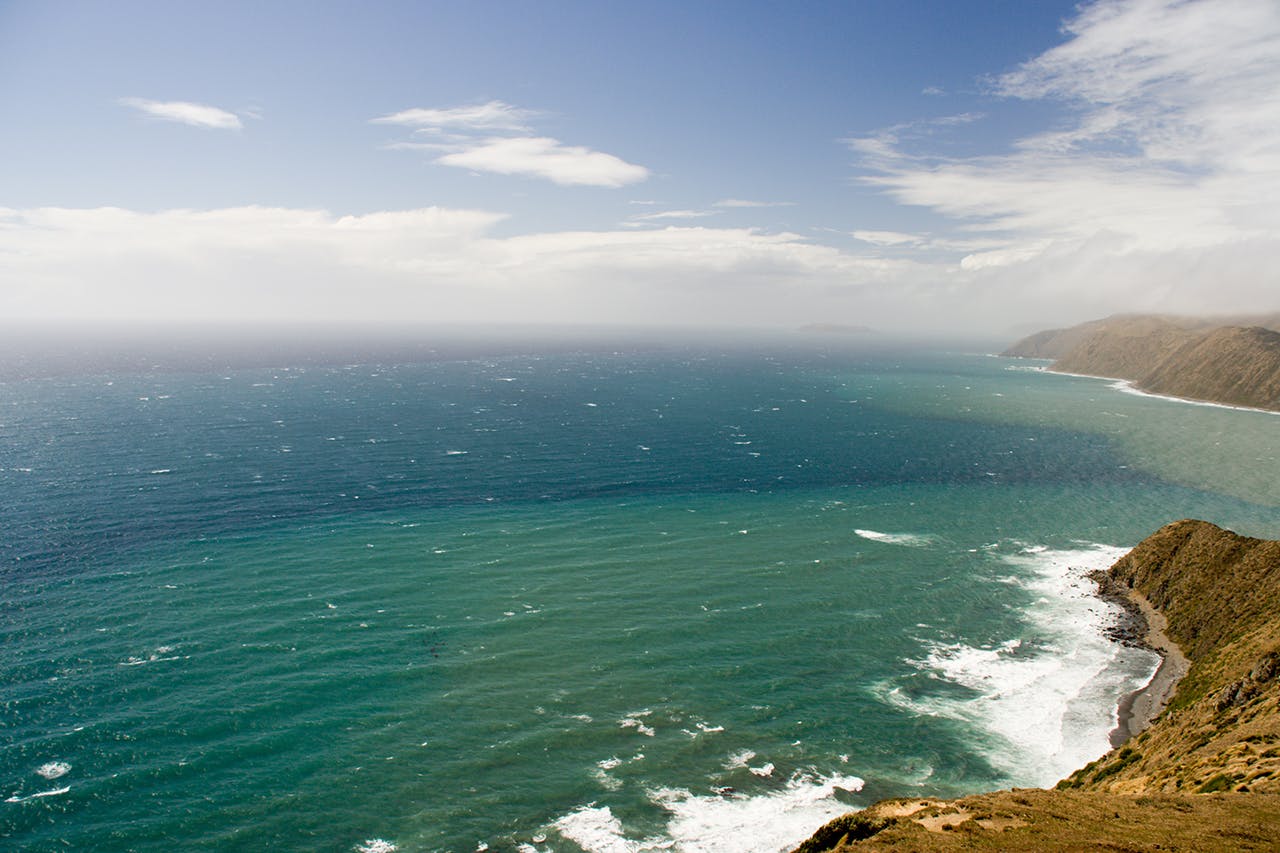
In the deep blue sea near Mana Island, pictured in the distance, Rob Hewitt found himself floating for four days. Photo: Aidan / Creative Commons
“I knew all the odds were stacked against me,” Hareb said. “I knew I was in pain, I kept falling over, falling back down, having to use all my strength to get back up and carry my bag. I knew if I got caught in that storm it would be quite an adverse situation, so I just kept going.”
Hareb’s adventure reinforced that being prepared for the worst is the best thing you can do. “Eighty per cent of success in the backcountry is having a good plan, and I’m very grateful I had a good plan. It would be a different story if I hadn’t. My advice? Don’t be scared of the terrain, just be very, very prepared.”
For Hewitt, never giving up was getting harder and harder. When the fourth day dawned, he was battling rough seas and persistent hallucinations that led him to remove some of his gear. “All of a sudden I woke up and my jacket was around my neck and I panicked, because I was always, always so careful about checking my gear and now I was getting rid of it. At this point, I’ve had enough. I start disengaging my will to live, which I realise had always been there, even if I didn’t know it at the time. I start taking off my dive gear until I’m lying in the water in a pair of wetsuit pants and a t-shirt, lying on my back with my arms open so the heat can escape. I closed my eyes.”
A very short time later, Hewitt was rescued by a boat containing two of his navy dive buddies. It took a long time for him to realise he wasn’t hallucinating. His body had already started to decompose while he was still alive, and recovery took a long time.
Three months after he was rescued, Hewitt returned to the place where he had become lost. His family and friends were with him, and he went to the ocean floor and said thank you.
“Even to this day, 10 years later, I’m still figuring out why,” Hewitt said. “After that ordeal, I realised that anything was possible. And if you get knocked back, well, it’s better than being out at sea. That experience was the closest I got to who I really am. And since I’ve been back, I haven’t been in that space. And it wasn’t a bad space to be in. It’s always there for all of us. It just takes a moment in our lives for us to realise our potential.”





